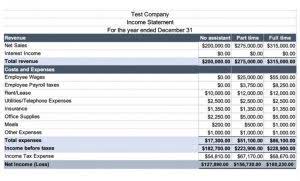
Restaurateurs and investors use EBITDA when they’re looking to sell, buy, or invest in a restaurant to help guide their buying decisions. It’s a tool for a valuing a restaurant and gauges a restaurant’s earning potential. You can create custom tags and categories to match your bookkeeping needs for tailored complex financial analysis and oversight. Digitizing these receipts reduces clutter and manual entry and makes them much more accessible. To ensure your restaurant stays within budget, meets deadlines and obligations, and achieves your goals, it’s crucial to monitor and manage your finances.

Inventory turnover ratio
Say goodbye to the complexities of bookkeeping, and let us handle your financial records with precision and efficiency. Restaurant bookkeeping involves several crucial steps to ensure accurate financial records and facilitate informed decision-making. Let’s explore four key practices that are essential for effective restaurant bookkeeping. Accounts that require reconciliation include loans, lines of credit, credit cards, bank accounts, and payroll liabilities. It’s a necessary process that ensures that nothing is left unaccounted for.
Top 5 Common Restaurant Accounting Mistakes and How to Avoid Them
- She has a degree in Journalism and now specialises in writing insightful content for businesses in the hospitality and retail industries.
- While no defined average food cost percentage is defined, this range has been a well-known standard for US-based food operators.
- Because of this, they require specific accounting methods and benchmarks that wouldn’t apply to, say, a retail store.
- Bookkeeping may also include the creation of financial statements and processing payroll.
- Under accrual accounting, CoGS is recorded as inventory is used, not when the suppliers are paid.
- On the downside, outsourcing accounting for your restaurant could lead to communication lapses, especially if they’re in a different time zone or city.
Keeping track of your financial situation helps you make better financial decisions and future-proof your business. At first blush, cash-based accounting might seem like the best kind for restaurants. It records income as it enters your bank account and records expenses when they’re paid. Cost of goods sold is a KPI that indicates how well you’re pricing your products and controlling your inventory. CoGS represents the actual cost of food and beverage used to produce your food and beverage sales. By keeping tabs on your CoGS ratio, you can take action to reduce and contain your inventory costs.
Reconcile all accounts

It handles data entry, generates customized invoices and profit and loss statements, and tracks revenue, expenses, and cash flow. Automating and streamlining everyday bookkeeping tasks frees up your time to focus on what you do best—running your restaurant. Accounting software can seamlessly aggregate your chart of accounts for you and populate key financial reports with accurate information. It can show you an overview of your key financial reports, such as your balance sheet, cash flow report, and profit and loss statement.

Monitor your financial progress:
But the US tax code favors traditional tipping systems through tax credits, while restaurants that charge fees don’t receive a similar benefit. A small business can likely do all its own bookkeeping using accounting software. Many of the operations are automated in the software, making it easy to get accurate debits and credits entered. bookkeeping for restaurants You can look at freelance sites, such as Upwork, to see what others are charging for bookkeeping services, but you can also learn a lot by asking around. Talk to businesses in your area to see what they are currently paying for bookkeeping services. Talk to people in your network who are also bookkeepers and ask what they are charging.
Additionally, when running payroll, you need to pay attention to what taxes need to be withheld for each employee. 1000more rows at the bottom Kristen Slavin is a CPA with 16 years of experience, specializing in accounting, bookkeeping, and tax services for small businesses. A member of the CPA Association of BC, she also holds a Master’s Degree in Business Administration from Simon Fraser University.
Cash Flow Management
You can work with other bookkeepers and tax experts to share and expand your knowledge. There are many opportunities to work in a salaried position from home to gain on-the-job training. The Intuit Tax and Bookkeeping Talent Community is a great place to find remote bookkeeping jobs and access training material. As more people move to working from home, freelancing, or starting their own businesses, you may want to learn how to become a virtual bookkeeper.
Setting Up Your Books
If you seek funding from a bank or investor, your business plan will be especially important because it is how potential lenders and investors will understand your business. The role can function as a part-time job to supplement other income, or you can be a full-time bookkeeper. If you become a QuickBooks Live bookkeeper, you can work from home based upon an agreed schedule at a set hourly rate based on your location, interview, and experience level.
What is a POS (Point of Sale) System and How Does it Work? [2024 UPDATE]
- Become one of them by making a call and placing an order for the best station.
- If you need to customize the report to get more detailed information you will need to work through the customization with your POS system.
- Freelance jobs can range from quick temporary projects to long-term employment.
- But the US tax code favors traditional tipping systems through tax credits, while restaurants that charge fees don’t receive a similar benefit.
- Bookkeeping is a crucial function of accounting, and earning a bookkeeping certification is a great way to show employers your expertise.
